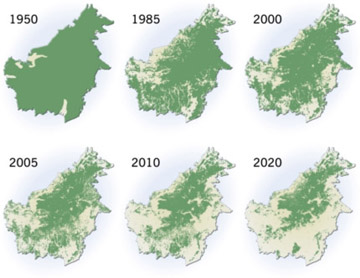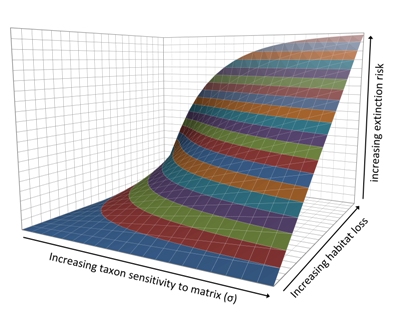But how are forests on the land different from islands in the sea in terms of species extinction?
 Figure 1: Extent of Deforestation in Borneo 1950-2005, Projection to 2020. The island of Borneo is split between Malaysia, Indonesia, and Brunei. Figure 1: Extent of Deforestation in Borneo 1950-2005, Projection to 2020. The island of Borneo is split between Malaysia, Indonesia, and Brunei. |
"One of the main differences between habitat islands and true islands is the intervening matrix," says Koh. By 'matrix', Koh does not mean an alternate reality where one can fight in slow-motion, but instead the type of landscapes in targeted areas, such as old-growth forests, secondary forest, small-scale agriculture, pasture, plantations, urban landscapes, and many others.
"In true island systems, the matrix is the ocean. It is quite reasonable to assume that most terrestrial organisms would not survive very well in this ocean matrix. The same, however, cannot be said of the matrix between habitat islands on a mainland because, in this case, the matrix could be a whole variety of land uses," Koh says, adding that "the main constraint of the conventional species-area model is that it assumes all organisms respond exactly the same to matrix (i.e. to be like an ocean)."
For example, a Komodo dragon cannot survive in the ocean and so its habitat is literally constricted to the islands it lives on. If those islands were to become inhabitable—for example if sea levels rose and swamped them—the Komodo dragon would go extinct. In turn, while a leopard cat surely thrives in pristine rainforest, it may also survive in partially logged forest and even in some agricultural areas. So, even if the leopard cat loses all of its forest habitat—or most of it—the species may survive in other areas.
However, the situation is far from simple. For example, one bird species may survive in forests and in certain types of agriculture, but another bird species may only survive in pristine forests, while a third may inhabit everything from forest to plantations to urban environments. So, how does one predict extinction in face of such complexities?
To answer this, Koh has developed a matrix-calibrated model that "takes account of the specific response of the organisms to each component of matrix". In other words Koh's model combines habitat loss with a species' sensitivity to surrounding matrices to determine the likelihood of extinction.
 The matrix model. The matrix model. |
Not satisfied with simply developing a new model, Koh tested the new model, dubbed the matrix model, against the conventional island biogeography theory and another theory, called the countryside model, in a "'prediction accuracy' competition". The test looked at survival of bird species in 20 biodiversity hotspots.
"The winner would be the model that produced predictions that were closest to actual known bird extinctions or endangerment," Koh said.
The matrix model took first prize. "I found that the matrix-calibrated model was the best model among all models considered, and it was 13.5 times more strongly supported by the data than the conventional model," Koh says. The countryside model proved least accurate of the three, while the conventional model overestimated extinction in 18 of 20 of the hotspots—not surprising since this model assumes all habitats outside of forest are unlivable which may be true for some species but hardly all.
If accepted by conservationists, the improved accuracy of the matrix model is likely to revolutionize where and how conservationists employ their resources.
"The matrix-calibrated model can now be used to explore the consequences of changes in the entire landscape, including not just the amount of forest but also the quality of the resultant land uses that now comprise the matrix. Not only will conservationists be able to make more accurate predictions of biodiversity loss from land-use change, they could also use the matrix-calibrated model to predict potential biodiversity enhancements from improvements in the quality of the matrix," Koh says, adding that "to me this is a significant step forward because now we can potentially prescribe measures to increase biodiversity!"
"Although the number of threatened species is less than estimated in some previous studies, we stress that ongoing and future land-use changes pose serious threats to Amazonian biodiversity. If the risk estimates from this study are applied to the 50,000 total vascular plant species (12,500 canopy trees) estimated to occur in the Amazon Basin, we predict that between 2,400 and 4,550 species (600–1,138 species of trees) will become committed to extinction over the next several decades because of land-use change alone," they write.
"This is an unacceptable loss rate and calls for strong and immediate conservation actions."
Please read full at mongabay